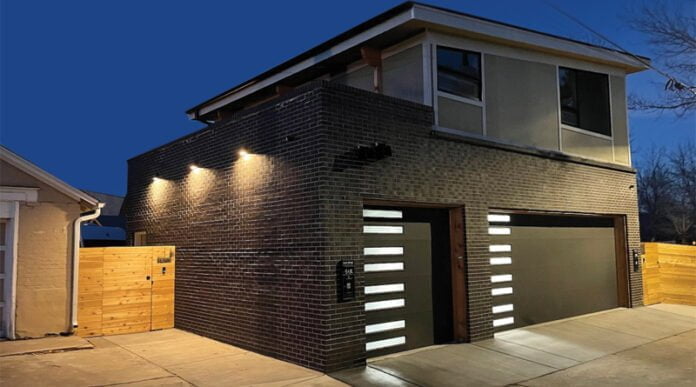Take a tour through the alleys of certain Denver neighborhoods, and a closer look will reveal big growth in one small kind of residence—accessory dwelling units (ADUs). These diminutive dwellings are keeping builders and landscapers alike busy, but this is a relatively new phenomenon. During the mid-20th century, middle-class urbanites fled cities in droves in favor of the flashy new suburbs. Attached two-car garages went up, porches came down, and local communities passed restrictive zoning ordinances precluding ADUs.
By the dawn of the new millennium, populations were surging in cities across the country, but the fastest growth occurred in the South and West, including Colorado. As a result, urban hubs like Denver now face issues like limited space, a shockingly low inventory of existing homes and the predominance of single-family zoning that have exacerbated the affordable housing crisis, and have made it difficult for those who could afford a home to purchase one in older, more established neighborhoods.
This confluence of circumstances resulted in strong nationwide demand for ADUs, including in the Denver metro area. In fact, almost 70,000 homes sold in 2019 included an ADU, representing 4.2% of all the homes sold on MLS, according to meticulous research conducted by Freddie Mac. The same study also revealed that between 2009 and 2018, the number of debut listings for ADUs (both rental and for-sale units) increased by a year-over-year average of 8.6%, a figure that seems primed for an uptick.
Kevin Anderson, partner with ArcWest Architects, a full-service design and architecture firm located in Denver’s Sloan’s Lake area, says his team is seeing “high demand” for ADUs. “It helps that the City of Denver is actively pursuing rezoning in certain neighborhoods to allow ADUs. A good example is Chaffee Park, where until recently, ADUs weren’t permitted, but with certain limitations, that option is now available.”
Coloradans from all walks of life cherish spending time outdoors, so as residential zoning continues to relax and more homeowners appreciate the opportunities ADUs offer, property owners are seeking experienced and innovative designers and landscapers who can strike the perfect balance between form and function for both homes.
The Fundamentals
Since an ADU is essentially a miniature house (typically) situated in the backyard of someone else’s larger home, designing landscapes and outdoor spaces for the small patches of earth generally afforded these diminutive dwellings is more challenging. With that in mind, three primary considerations will impact both the design and degree of difficulty associated with an ADU’s outdoor space.
- How does the homeowner plan to use the ADU?
While perhaps a bit self-evident, understanding precisely how the client intends to use their ADU, not to mention their expectations regarding form and function, is crucial. Not only do they inform almost every landscape or design decision, but it’s also an opportunity to educate and advise the owner.
“Your ability to listen is crucial to success,” advises Duane O’Hara, president of Denver-based The Wild Irishman Tree and Landscape. “Taking the time to form connections with people lets you get a good feel for what they like and want, but I also emphasize that doing my best work is what’s most important, which lets me offer my expert opinion when it’s needed. That can lead to conversations on the benefits of quality goods and native plants, which leads to more ideas, and in the end, more lucrative projects.”
In practice, people seldom build or renovate a separate structure for their own personal use (as with workshops and hobby spaces, for example), and despite commonly used colloquialisms like “in-law suites” or “granny flats,” relatively few homeowners intend to provide nearby housing for family members. To wit, Anderson estimates, “At least 80% of the ADUs we work on are for income generation.”
If the primary resident is aiming to create something of a small family compound, in which the ADU will be inhabited by an aging parent, adult children with young families or even near-adult teenagers, the intent is to keep loved ones close. Therefore, these property owners tend to favor more open landscapes between structures, plenty of shared outdoor space, and easy access to and from each abode.
Conversely, clients looking to cultivate a new income channel by renting out their ADU are generally more concerned with maintaining privacy for both homes, and that means carving out separate and distinct outdoor spaces for each residence, while other considerations may include separate access points, parking and fencin
- A conversion or an all-new ADU?
Accessory dwelling units can appear in a surprising variety of forms, including repurposed areas of a primary residence such as an attic or a basement with outdoor access; however, most Denver-area ADUs are converted garages or carriage houses, which tend to occupy their own little spot of land. In fact, Anderson estimates that garage-converted ADUs account for roughly 90% of his company’s current projects.
“In Denver, most detached ADUs are located on the back 35% of the lot,” says Anderson. “Oftentimes, the small setbacks between the garage and the property line is where most of their outdoor space lies.”
Related: WDRC’s ADU initiative aims to increase affordable housing options
Generally speaking, the smaller the ADU, the more outdoor space you have to exploit. So if your client is building from scratch, opportunities to plan for stunning landscapes are that much more plentiful.
- The lay of the land
Clearly, the size of the homeowner’s lot itself plays a lead role in determining landscape design, and while other factors such as configuration, structural positioning, zoning restrictions, grading and drainage are equally important, there are many more considerations to ensure balance, function and form between the ADU and the primary residence.
Thanks to Colorado’s dry, sunny climate, water-wise landscaping is often at the forefront of new landscaping projects, including ADUs. In addition to being less expensive in the long run and more environmentally friendly, the added benefit of reduced watering responsibilities cannot be ignored.
“We always make an assessment for planting xeriscape with native plant materials that peak in the spring, summer and fall,” says O’Hara, emphasizing the importance of a full-season picture when choosing softscape materials.
Another seasonal consideration pertains to providing shade in the summer and sun in the winter. This means evaluating positioning with an eye not only on the ADU itself, but also how new structures, fences or trees may obstruct neighboring homes’ lines of site or sun exposure.
Since the southern facing side of any structure gets the most sun, it’s a good idea to add a trellis, shrub or tree to provide summer shade and capture the winter sun, Anderson suggests.
A space of their own
ADUs are a great many things, but the one thing they’re not is spacious, so designs that include easy access to the great outdoors along with a little patch of earth dedicated to the ADU are essential.
“Accessory dwelling units are small, so giving [residents] an outdoor space is crucial,” agrees Anderson. “Even if you only have five feet of depth in a side yard, they need a little place to sit, grill, garden or let their dog run.”
O’Hara concurs, adding, “Making that precious outdoor space functional is important, and there are so many ways to do it, but they all depend on the owner’s goals and personal tase. Outdoor kitchens, pathways, places just to sit, water features and flower boxes are a few examples, but I also like adding cold boxes and including surprising things like edible flowers.”
How residents are expected to access that area—especially if the property owner wants a bit more privacy when coming and going from a garage ADU—also merits exploration.
“To open up a secondary outdoor space in garage ADUs, we strongly encourage adding another door to the backyard side of the structure,” suggests Anderson. “French doors, patio doors or even traditional garage roll-ups can give the residence a covered, flexible entertainment space.
Despite their lilliputian landscapes, these practical tips and strategies are proof positive that designing a masterful outdoor experience for ADUs is indeed possible—it just requires equal portions of big-picture thinking and attention to little details.









